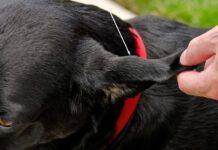As a professional dog trainer, and as someone who teaches other people how to train their own dogs, I find that with the proper instruction, most people can effectively train their dogs with nothing more than a plain buckled collar and regular leash. Contrary to the manufacturers’ claims, no collar, leash, or harness will ever work an effortless training “miracle” on your dog.
However, I have found certain pieces of training equipment to be helpful in specific cases. (A good example is the “head collar,” discussed in “Gear of the Year,” WDJ November 1998.) This month, I looked at several “special purpose” collars and novel leash attachments.
No-Slip Collars
No-slip collars are another special-purpose training tool that can be valuable in certain cases. I use only positive reinforcement training methods, and generally don’t allow the use of choke chains in my training classes. But occasionally a student explains that she uses a choke chain because her dog slips out of a regular collar unless it is tightened to the point of the dog’s discomfort.
In the interest of helping people who have found themselves in similar circumstances, I tested three collars designed to prevent dogs from slipping away. However, these collars prohibit unlimited choking, making them much more humane options than standard choke collar.
CAUTION: Slip collars can choke a dog that is tied up. This risk is less than of choke chains, but regardless, you should Never tie a dog that is wearing a no-slip collar.
WDJ Approves
The Premier Collar, Premier Pet Products, Richmond, VA; phone (804) 379-4702. Also available at most pet supply stores; about $7.
The Premier Collar is the most common of the no-slip collars. It consists of two pieces of nylon linked together by sturdy metal brackets. The main piece is similar to a standard adjustable nylon collar, while the second piece forms a loop that slips through brackets that are sewn in to the two ends of the first piece. The leash ring is sewn into the loop, so that when a dog pulls back on the collar the loop tightens, which tightens the collar around his neck and prevents him from slipping free.
The collar comes in a wide variety of sizes and colors. I liked the concept of the collar, and tried it on several dogs, none of whom objected to the mild tightening. I found it decidedly preferable to a choke chain. All collars were adjusted properly, so that abusive choking was impossible.
Not Recommended
The Check Choke, Coastal Pet Products, Inc., Alliance, OH; available at pet supply stores; about $10.
The highest priced of the three no-slip collars I found, the Check Choke was also the one I liked the least. Instead of a nylon strap, the Check Choke uses a chain as the second loop. Worse, the instructions that come with the collar encourage “a quick, short jerk” on the collar as a correction – something I do not use or approve of in my training. The collar appears well-made, but even the name implies the intent of its use as a force-based, coercive training tool.
WDJ’s Top Pick
The Lupine Combo Collar, Lupine Company, Conway, NH; phone (800) 228-9653l; about $8.
This was my top choice of the three no-slip collars I tested. Although almost identical in design to the Premier Collar, there are two notable differences. The Lupine Combo Collar has a “dead ring” sewn into the collar just next to the loop. When the leash is attached to the dead ring, the collar acts like a regular collar. Nice option!
Also, the quality of the Lupine collar is superior to the Premier, with sturdier, softer nylon and better stitching. Although both collars appear suitable, I like the Lupine better and feel it is well worth the extra dollar, especially since Lupine also offers a lifetime guarantee replacement or refund policy.
Other special-purpose collars
We’ve all seen reflective dog collars, which are usually billed as “designed to protect dogs from being hit by cars,” but what are dogs doing loose in the street at night (or any other time, for that matter) anyway? However, the reflector collar could be a useful safety feature for an owner who walks or jogs along a road with his dog at dusk or in the dark – in which case we hope the jogger also wears reflective clothing!
The most useful refective collar I’ve seen yet is one that boasts a “glow in the dark” feature in addition to the reflecting property.
WDJ Approves
The Safe-T-Bright Collar, The Dog’s Outfitter, Hazelton, PA; phone (800) 367-3647; about $5.
This adjustable nylon reflector collar glows in the dark for more than 20 minutes after exposure to light. I’ll admit that the glow-in-the-dark element was helpful for keeping track of my dark brown dog in the woods at night, but since the glow only works for the first 20 minutes or so, its usefulness seems a bit limited.
However, I can think of one perfect application: How about the dog who “disappears” into the dark corners of the backyard when he’s been let outside to go to the bathroom at night, trying to extend his evening explorations? The Safe-T-Bright collar could help locate the dog more quickly.
“Convenience-leash” collars
Many of us like to drop the leash when off-leash play is appropriate, but it’s also nice to have a quick way to re-secure the dog if need be. A few years ago, I saw a collar with a built-in retractable leash that I thought was quite charming. But even after an hour spent leafing through a tall stack of dog product catalogs, I couldn’t find one! I did see a couple of collars that came close. They, too, were designed to provide a hold on the dog that could be dropped and regained quickly.
WDJ Approves
The Hand-E-Lead, The Dog’s Outfitter, Hazleton, PA; phone (800) 367-3647; about $10.
The “Hand-E-Lead,” a small (2” diameter) retractable lead that attaches to the dog’s collar, came the closest to duplicating the retractable-leash collar I saw years ago.
The Hand-E-Lead attaches to the leash ring on your dog’s collar. According to the package, it’s designed to always be carried on the dog’s collar – a nice idea, but I wouldn’t leave it on all the time. On my 45-pound dog, it hung down and banged on her chest when she moved, which would surely get annoying over time.
The attraction is this: When the handler drops the leash, it retracts, staying conveniently available, but out of the way. However, while it’s compact and easy to use, it is just a little too big to be used on a small or small-to-medium sized dog. The chest-banging might not bother a larger dog, but since the retractable cord is said to “hold up to 150 pounds,” it might not be strong enough to hold a large, exuberant dog. In addition, the handle that you hold is small, which could make it difficult to grip, and therefore, unsafe to use on a hard-to-control dog.
Even given all of these limitations, I have to say that I would attach and use this for specific outings on a relatively well-behaved dog. If you have the right dog, this could be a fun toy for you, eliminating the necessity of dragging a leash along with you everywhere. If you have a large, powerful dog who has not yet learned to walk politely on leash, I suggest you hold off on the Hand-E-Lead.
Not Recommended
The Handler Dog Collar, UPCO, St. Joseph, MO; phone (800) 254-8726; $50.
With a secure and easily grasped handle fastened right to the collar, the idea here is that you don’t need a leash at all. But given its heavy bridle leather construction, this is one hefty, stiff, and expensive collar. My 75-pound test dog hated it, and although it was the right size for him, he looked lost in it.
The accompanying literature says the Handler is supposed to keep the dog by your side for “improved communication and control.” But I felt that the constant contact with the dog’s neck was likely to agitate many dogs rather than increase control. While it might appeal to someone who wanted their big tough dog to look bigger and tougher, I would advise the average dog owner to pass on this one.
-By Pat Miller
Pat Miller is a regular contributor to WDJ. A freelance writer and dog trainer, she lives in California.





